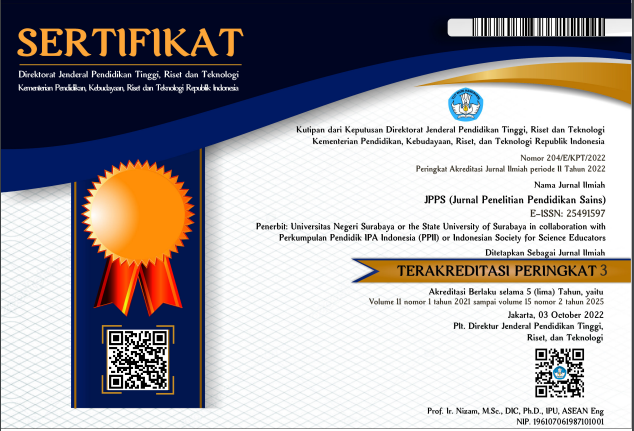Profile of Computational Thinking Skills in Environmental Chemistry Courses for Prospective Science Teacher Students
DOI:
https://doi.org/10.26740/jpps.v11n2.p152-165Keywords:
Computational thinking, Environmental chemistry course, Field studyAbstract
Computational thinking skills are not only provided to students in computer-related courses, but also in all courses, including Environmental Chemistry courses. Environmental chemistry courses are considered important because they orient students to the achievement of scientific literacy and awareness. Therefore, optimization of learning in environmental chemistry courses also needs to be carried out to support the achievement of CPL which includes 21st-century life skills, including computational thinking skills. science teacher candidates. The research method follows 3 stages of field study, namely preparation, data collection, and data analysis. The results of the study show that the Science Education Study Program has poured CT skills into CPL, environmental chemistry lectures are still dominated by theoretical explanations by lecturers, lecturers do not understand the concept of CT, and CT skills are very important to provide students.
Downloads
References
Anistyasari, Y., Ekohariadi, & Munoto. (2020). Strategi pembelajaran untuk meningkatkan keterampilan pemrograman dan berpikir komputasi: Sebuah studi literatur. Journal of Vocational and Technical Education, 2(2), 37-44. https://doi.org/10.26740/jvte.v2n2.p37-44
Bandur, A. (2016). Penelitian kualitatif: Metodologi, desain, dan teknik analisa data dengan nvivo 11 plus. Jakarta: Deepublish Press.
Barr, D.H., & Conery, L. (2011). Computational thinking: A digital age skill for everyone. Learning & Leading with Technology, 38, 20-23.
Denning, P.J. (2017). Remaining trouble spots with computational thinking. Communication of The ACM, 60(6), 33-39. https://doi.org/10.1145/2998438
Cahyo, A. N. (2011). Gudang permainan kreatif khusus asah otak kiri anak. Yogyakarta: FlashBooks.
Chongo, S., Osman, K., & Nayan, A.N. (2021). Impact of the Pulgged-in and Unplugged Chemistry Computational Thinking Modul on Achievement in Chemistry. Eurasia Journal of Mathematics, Science, and Technology Education, 17(4). https://doi.org/10.29333/ejmste/10789
CSTA. (2011). Computational thinking teacher resources. National Science Foundation Under Grant.
Grover, S., & Pea, R. (2018). Computational thinking: A competency whose time has come. in s. sentance, e. barendsen & c. schulte (Eds.) London: Bloomsbury Academic.
Hunsaker, E. (2020). The K-12 educational technology handbook. EdTechBook.
Junaedi, A. (2020). Buku panduan penyusunan kurikulum pendidikan tinggi di era industri 4.0 untuk mendukung merdeka belajar-kampus merdeka (ke-4 ed.). Jakarta: Direktorat Pembelajaran dan Kemahasiswaan, Dirjen Dikti, Kemendikbud.
Kalelio?lu, F. (2018). Characteristics of Studies Conducted on Computational Thinking: A content analysis, in computational thinking in the STEM disciplines foundations and research highlights, ed. myint swe khine. Switzerland: Springer International Publishing.
Kemendikbud RI. (2020). Peraturan menteri pendidikan dan kebudayaan republik indonesia nomor 3 tahun 2020 tentang standar nasional pendidikan tinggi. Jakarta: Kemendikbud.
Kraska, T. (2020). Establishing a connection for students between the reacting system and particle model with games and stochastic simulations of the arrhenius equation. Journal of Chemical Education, 97(7), 1951-1959. https://doi.org/10.1021/acs.jchemed.0c00081
http://dx.doi.org/10.1109/EDUCON.2018.8363437
Lutfi, A., Suyono, Erman, & Hidayah, R. (2019). Edutainment with computer game as chmistry learning media. Jurnal Penelitian Pendidikan Sains, 8(2), 1684-1689. https://doi.org/10.26740/jpps.v8n2.p1684-1689
Moon, J., Do, J., Lee, D., & Choi, G.W. (2020). A conceptual framework for teaching computational thinking in personalized OERs. Smart Learning Environments, 7(6), 1-19. https://doi.org/10.1186/s40561-019-0108-z
Mulyani, E. (2016). Pengaruh penggunaan model pembelajaran kooperatif tipe student facilitator and explaining terhadap pemahaman matematik peserta didik. Jurnal Penelitian Pendidikan dan Pengajaran Matematika, 2(1), 29-34. https://doi.org/10.37058/jp3m.v2i1.151
Ngoc, T.H., Nhan, P.V., Son, H.D., Ai Duc, T.T., & Nam, T.G. (2020). Lecturer professional development strategies in a higher education institution in ha tinh province at a time of educational reforms. Eucational Studies Moscow, 2, 128-151. 10.17323/1814-9545-2020-2-128-151
Peel, A., Sadler, T.D., & Friedrichsen, P. (2021). Using unplagged computational thinking to scaffold natural selection learning. The American Biology Teacher, 83(2), 112-117. http://dx.doi.org/10.1525/abt.2021.83.2.112
Riva, I. (2012). Koleksi games edukatif di dalam dan luar sekolah. Yogyakarta: FlashBooks.
Rizki, & Putra, W. Y. (2019). Pengembangan bahan ajar gamifikasi matematika siswa MTs. Jurnal Penelitian dan Pembelajaran Matematika, 12(1).
http://dx.doi.org/10.30870/jppm.v12i1.4865
Schunk, D.H. (2012). Learning theories an educational perspective (teori-teori pembelajaran: perspektif pendididkan) (ke-6 ed.). Yogyakarta: Pustaka Pelajar.
Sugiyono. (2015). Metode penelitian pendidikan. Bandung: Alfabeta.
Widianto, S. (2020). Korelasi motivasi, fasilitas belajar, dan prestasi belajar siswa. Awwaliyah: Jurnal PGMI, 3(1), 47-56.
Wing, J.M. (2006). Computational thinking. Communications of the ACM, 49(3), 33-35.
Yakin, Q.R., Suwindra, I. P., & Mardana, I. P. (2018). Pengembangan media pembelajaran game edukasi fisika untuk meningkatkan motivasi dan prestasi belajar siswa pada materi gerak-gerak lurus beraturan, berubah beraturan, dan jatuh bebas. Jurnal Pendidikan Fisika Undiksha, 8(2), 21-30. https://doi.org/10.23887/jjpf.v8i2.20634
Yusoff, K.M., Ashaari, N.S., Wook, T.M., & Ali, N.M. (2021). Validation PF the components and elements of computational thinking for teaching and learning programming using the fuzzy delphi method. International Journal of Advanced Computer Science and Applications (IJACSA), 12(1). https://doi.org/10.14569/IJACSA.2021.0120111
Zhong, B., Wang, Q., Chen, J., & Li, Y. (2016). An exploration of three-dimensional integrated assessment for computational thinking. Journal of Educational Computing Research, 53(4), 562-590. http://dx.doi.org/10.1177/0735633115608444
Downloads
Published
How to Cite
Issue
Section
License
Copyright (c) 2022 JPPS (Jurnal Penelitian Pendidikan Sains)

This work is licensed under a Creative Commons Attribution-ShareAlike 4.0 International License.
 Abstract views: 382
,
Abstract views: 382
, PDF Downloads: 449
PDF Downloads: 449












